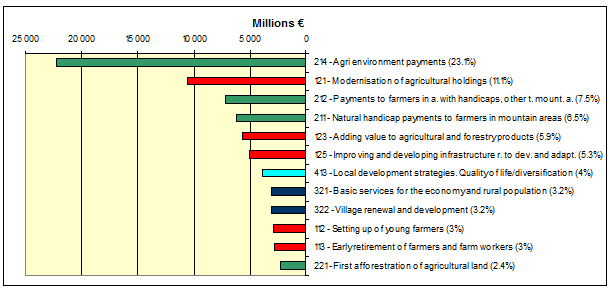Are we as taxpayers getting good value for money from agri-environment payments under the EU’s rural development (RD) policy? This is an important question, given that agri-environment payments will amount to around €22 billion during the 2007-2013 RD programming period, alone accounting for around 23% of all Pillar 2 spending. It becomes more important given that the Commission is flagging that it wants to direct even more funding towards the provision of environmental public goods in the next programming period.
 Breakdown EU Rural Development spending 2007-2013
Breakdown EU Rural Development spending 2007-2013A European Court of Auditors report published last Monday (September 19) provides a rather critical response to this question. The Court summarises its findings as follows:
Agri-environment is a key EU policy which aims to respond to society’s increasing demand for environmental services. This report assesses whether this policy is well designed and managed. The Court found that the conditions for assessing whether or not the objectives of the policy have been achieved are not in place. The systems for providing guidance to farmers were generally well implemented. However, considerable problems were identified concerning the aid amounts. Most expenditure was made on basic horizontal schemes without applying selection procedures and without clear decisions about the desirable degree of targeting. Although the audit identified good practices, the weaknesses found by the Court have hampered optimal achievement of the main objectives of agri-environment, namely contributing to EU-level priority areas (biodiversity, water, climate change) and improving the environment and the countryside.
The Court concludes its audit with four recommendations. Two of these relate to improved Commission oversight of the way Member States implement the relevant EU legislation.
Member States are criticised because often their rural development programmes do not contain clear environmental objectives. Where objectives are specified, there is often little linkage made between these objectives and the environmental sub-measures to be funded. Where the linkages are made, there is often little attempt made to monitor the impact of the measure, and little information was available on the environmental benefits of agri-environmental schemes. Aid payments to farmers often do not provide the right incentives, either over-compensating farmers in some cases or not compensating enough in other cases to ensure sufficient participation to really make an environmental difference. All of these issues are addressed in the legislation, and despite some rebuttal of the Court’s criticisms in the Commission’s replies to the audit, clearly there is still some way to go before good practice is routine in the Member States.
Court calls for more targeting of agri-environmental payments
The other two recommendations are more far-reaching because they raise a fundamental policy issue for future agri-environmental schemes. The Court found that, in the 8 regions it examined, the great bulk of agri-environment payments were made through broad, ‘horizontal’ measures available to all farmers in the region, often 80% or more of the total. It also noted that part of this expenditure is for maintaining existing favourable farming practices. It questioned whether in many cases there is an environmental benefit from this expenditure.
One of the more striking statistics in the report is that the Court found no evidence of specific environmental pressures in 39%, almost two-fifths, of the 203 individual environmental contracts it examined. In other words, within a 10 km radius of these farms, there was no evidence of water pollution; no evidence of marginalisation or abandonment of farming; no evidence of threats to exceptional plant diversity; no evidence of soil degradation; no threats to animal populations or animal biodiversity; no threats to plant communities in areas with normal biodiversity; and no evidence of landscape degradation.
The Court’s response to this finding is worth quoting in full:
A rational way to implement agri-environment policy is, on the basis of clearly identified environmental problems, to determine the required targets for impacts and participation levels and on this basis to determine the necessary financial resources. Identifying environmental problems means that there must be an environmental threat justifying why farming practices must be maintained or changed. Failure to apply this logic leads to an insufficient focus on environmental effects. Thus, the audit found that in 39 % of the 203 contracts reviewed, there were no specific environmental pressures in the area where the contract was implemented, or such problems could not be identified by the Member States…
The Court concluded that the large amounts of money spent on entry-level schemes, in contrast to the small amounts spent on higher-level schemes, were insufficiently justified in the rural development programmes concerning their environmental effects.
It favoured, instead, targeting funds to geographical areas, types of farms or farming practices by setting appropriate eligibility criteria. It noted that ensuring that funds are spent according to regional needs and priorities is of key importance for enhancing the environmental effects of agri-environment sub-measures.
The Commission’s defence of the status quo is that ‘the purpose of agri-environment support is not only to address environmental pressures but also to maintain and enhance environmental potentials and opportunities’. Its argument seems to be that it ok to provide agri-environment payments now to farmers without evident environmental problems in order to prevent such problems arising in the future.
The Court was not convinced by this argument. Instead, it recommended that the Commission should consider whether expenditure should be more precisely targeted to specific environmental needs in the next programming period. Specifically, it recommended that:
The Commission in its response defended the mix of basic and higher level schemes, noting that basic schemes, if well designed and implemented, can offer significant environmental benefits at relatively low cost. However, it did accept that better targeting of agri-environment payments is necessary and is envisaged in the framework of the CAP post 2013.
One wonders what the mix between basic and higher level schemes would be if agri-environment payments were managed by Ministries of the Environment rather than Ministries of Agriculture?


Thanks, very useful article that i think a lot of you will find useful